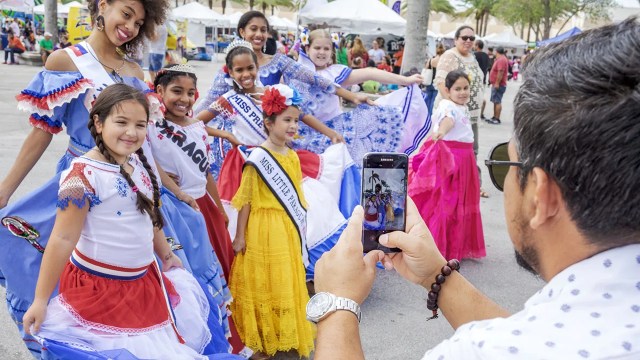
Debates over who is Hispanic have often fueled conversations about identity among Americans who trace their heritage to Latin America or Spain.
So, who is considered Hispanic in the United States today? How exactly do the federal government and others count the Hispanic population? And what role does race play in deciding who counts as Hispanic?
We’ll answer these and other common questions here.
To answer the question of who is Hispanic, this analysis draws on about five decades of U.S. Census Bureau data and about two decades of Pew Research Center surveys of Hispanic adults in the United States.
National counts of the Latino population come from the Census Bureau’s decennial census (this includes P.L. 94-171 census data) and official population estimates. The bureau’s American Community Survey (ACS) provides demographic details such as race, country of origin and intermarriage rates. Some ACS data was accessed through IPUMS USA from the University of Minnesota.
Views of Hispanic identity draw on the Center’s National Survey of Latinos (NSL), which is fielded in English and Spanish. The survey has been conducted online since 2019, primarily through the Center’s American Trends Panel (ATP), which is recruited through national, random sampling of residential addresses. This way nearly all adults have a chance of selection. The survey is weighted to be representative of the U.S. Hispanic adult population by gender, Hispanic origin, partisan affiliation, education and other categories. Read more about the ATP’s methodology. The NSL was conducted by phone from 2002 to 2018.
Read further details on how the Census Bureau asked about race and ethnicity and coded responses in the 2020 census. Here is a full list of origin groups that were coded as Hispanic in the 2020 census.
How many Hispanics are in the U.S. today?
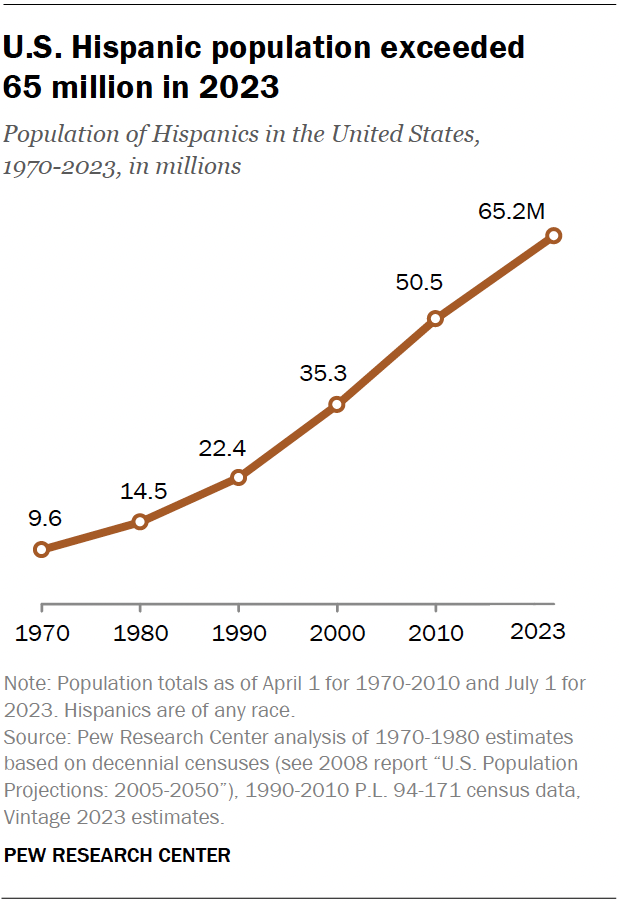
The Census Bureau estimates there were 65.2 million Hispanics in the U.S. as of July 1, 2023, a new high. They made up more than 19% of the nation’s population.
How are Hispanics identified and counted in government surveys, public opinion polls and other studies?
Before diving into the details, keep in mind that some surveys ask about Hispanic origin and race separately, following current Census Bureau practices – though these are soon to change.
One way to count Hispanics is to include those who say they are Hispanic, with no exceptions – that is, you are Hispanic if you say you are. Pew Research Center uses this approach in our surveys, as do other polling firms such as Gallup and voter exit polls.
The Census Bureau largely counts Hispanics this way, too, but with some exceptions. If respondents select only the “Other Hispanic” category and write in only non-Hispanic responses such as “Irish,” the Census Bureau recodes the response as non-Hispanic.
However, beginning in 2020, the bureau widened the lens to include a relatively small number of people who did not check a Hispanic box on the census form but answered the race question in a way that implied a Hispanic background. As a result, someone who answered the race question by saying that they are “Mexican” or “Argentinean” was counted as Hispanic, even if they did not check the Hispanic box.
From the available data, the exact number of respondents affected by this change is difficult to determine. But it appears to be about 1% of Hispanics or fewer, according to a Pew Research Center analysis of U.S. Census Bureau data.
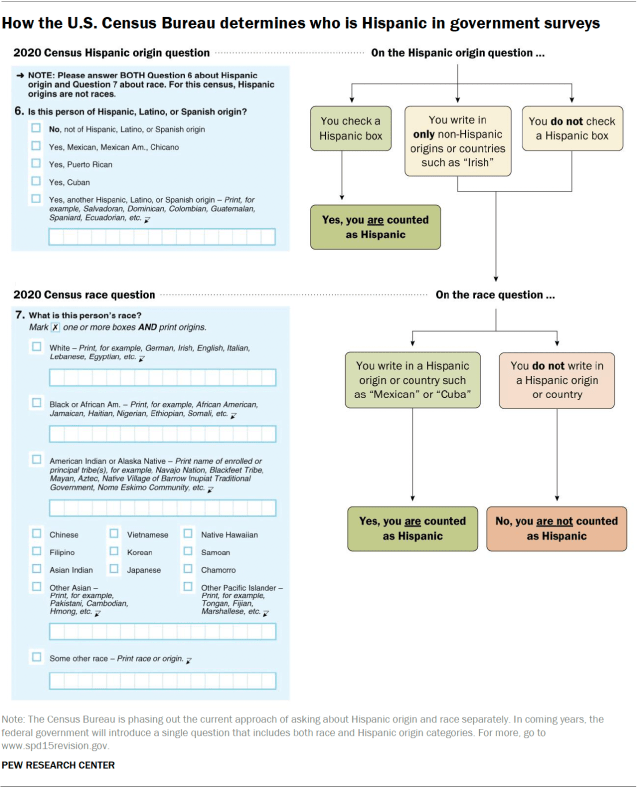
How do Hispanics identify their race in Census Bureau surveys?
In the eyes of the Census Bureau, Hispanics can be of any race, because “Hispanic” is an ethnicity and not a race. However, this distinction is subject to debate. A 2015 Center survey found that 17% of Hispanic adults said being Hispanic is mainly a matter of race, while 29% said it is mainly a matter of ancestry. Another 42% said it is mainly a matter of culture.
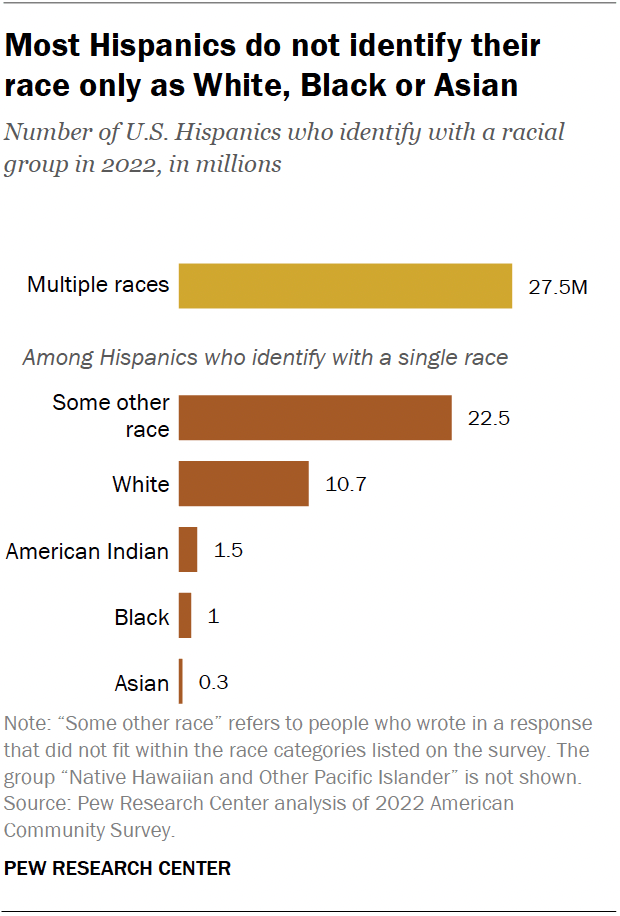
Nonetheless, the Census Bureau’s 2022 American Community Survey (ACS) provides the self-reported racial identity of Hispanics: 22.5 million single-race Hispanics identified only as “some other race.” This group mostly includes those who wrote in a Hispanic origin or nationality as their race. Another 10.7 million identified as White. Fewer Hispanics identified as American Indian (1.5 million), Black (1.0 million) or Asian (300,000).
Multiracial Hispanics
Another roughly 27.5 million Hispanics identified as more than one race in 2022, up from just 3 million in 2010.
Growth in the number of multiracial Hispanics comes primarily from those who identify as White and “some other race.” That population grew from 1.6 million to 24.9 million between 2010 and 2022. The number of Hispanics who identify as White and no other race declined from 26.7 million to 10.7 million.
The sharp increase in multiracial Hispanics could be due to several factors, including changes to the census form introduced in 2020 that added more space for written responses to the race question and growing racial diversity among Hispanics. This explanation is supported by the fact that almost 25 million of the Hispanics who identified as two or more races in 2022 were coded as “some other race” (and wrote in a response) and one of the specific races (such as Black or White). About 2.6 million Hispanics identified with two or more of the five major races offered in the census.
Changes for the 2030 census
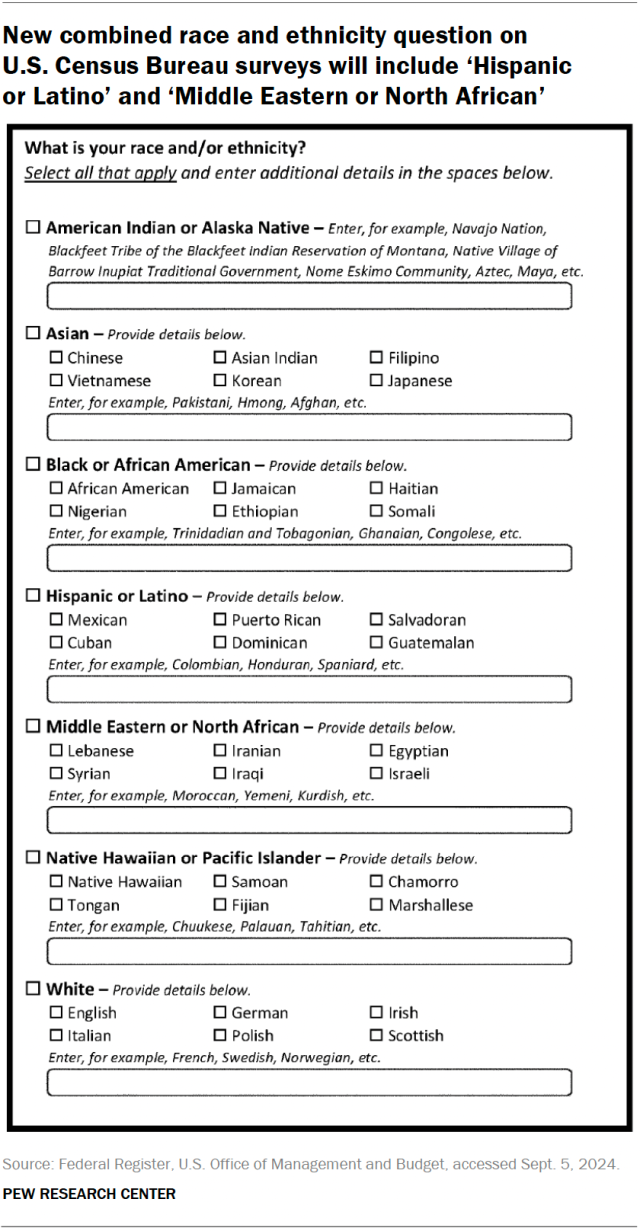
The 2030 census will combine the race and ethnicity questions, a change that other federal surveys will implement in coming years. The new question will add checkboxes for “Hispanic or Latino” and “Middle Eastern or North African” among other race groups long captured in Census Bureau surveys.
Officials hope the changes will reduce the number of Americans who choose the “Some other race” category, especially among Hispanics. However, it’s worth noting that public feedback has raised a variety of concerns, including that combining the race and ethnicity questions could lead to an undercount of the nation’s Afro-Latino population.
Is there an official definition of Hispanic or Latino?
In 1976, Congress passed a law that required the government to collect and analyze data for a specific ethnic group: “Americans of Spanish origin or descent.” That legislation defined this group as “Americans [who] identify themselves as being of Spanish-speaking background and trace their origin or descent from Mexico, Puerto Rico, Cuba, Central and South America, and other Spanish-speaking countries.” This includes around 20 Spanish-speaking nations from Latin America and Spain itself, but not Portugal or Portuguese-speaking Brazil.
To implement this law, the U.S. Office of Management and Budget (OMB) developed Statistical Policy Directive No. 15 (SPD 15) in 1977, then revised it in 1997 and again in March 2024. In the most recent revision, OMB updated racial and ethnic definitions when it announced the combined race and ethnicity question. The current definition of “Hispanic or Latino” is “individuals of Mexican, Puerto Rican, Salvadoran, Cuban, Dominican, Guatemalan, and other Central or South American or Spanish culture or origin.”
The Census Bureau first asked everybody in the U.S. about Hispanic ethnicity in 1980. But it made some efforts before then to count people who today would be considered Hispanic. The Census Bureau also has a long history of changing labels and shifting categories. In the 1930 census, for example, the race question had a category for “Mexican.”
The first major attempt to estimate the size of the nation’s Hispanic population came in 1970 and prompted widespread concerns among Hispanic organizations about an undercount. A portion of the U.S. population (5%) was asked if their origin or descent was from the following categories: “Mexican, Puerto Rican, Cuban, Central or South American, Other Spanish” or “No, none of these.”
This approach indeed undercounted about 1 million Hispanics. Many second-generation Hispanics did not select one of the Hispanic groups because the question did not include terms like “Mexican American.” The question wording also resulted in hundreds of thousands of people living in the Central or Southern regions of the U.S. being mistakenly included in the “Central or South American” category.
By 1980, the current approach – in which someone is asked if they are Hispanic – had taken hold, with some changes to the question and response categories since then. In 2000, for example, the term “Latino” was added to make the question read, “Is this person Spanish/Hispanic/Latino?”
What’s the difference between Hispanic and Latino?
“Hispanic” and “Latino” are pan-ethnic terms meant to describe – and summarize – the population of people of that ethnic background living in the U.S. In practice, the Census Bureau often uses the term “Hispanic” or “Hispanic or Latino.”
Some people have drawn sharp distinctions between these two terms. For example, some say that Hispanics are from Spain or from Spanish-speaking countries in Latin America, which matches the federal definition, and Latinos are people from Latin America, regardless of language. In this definition, Latinos would include people from Brazil (where Portuguese is the official language) but not Spain or Portugal.
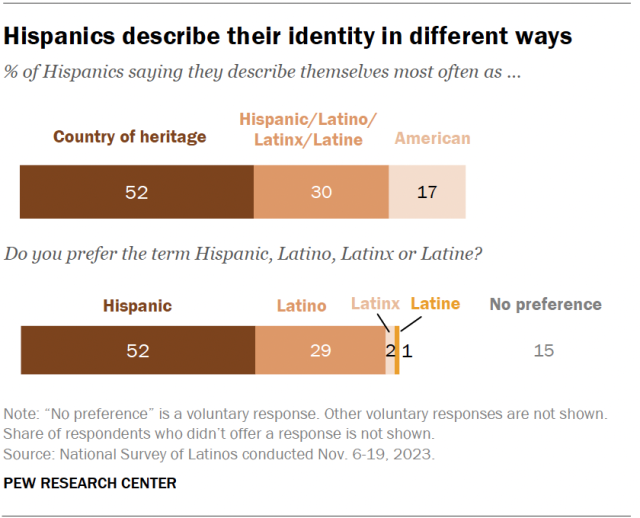
Pan-ethnic labels like Hispanic and Latino, though widely used, are not universally embraced by the population being labeled. Our 2023 National Survey of Latinos shows a preference for other terms to describe identity: 52% of respondents most often described themselves by their family’s country of origin, while 30% used the terms Hispanic, Latino, Latinx or Latine, and 17% most often described themselves as American.
The 2023 survey also finds varying preferences for pan-ethnic labels: 52% of Hispanics prefer to describe themselves as Hispanic, 29% prefer Latino, 2% prefer Latinx, 1% prefer Latine and 15% have no preference.
What is ‘Latinx’ and who uses it?
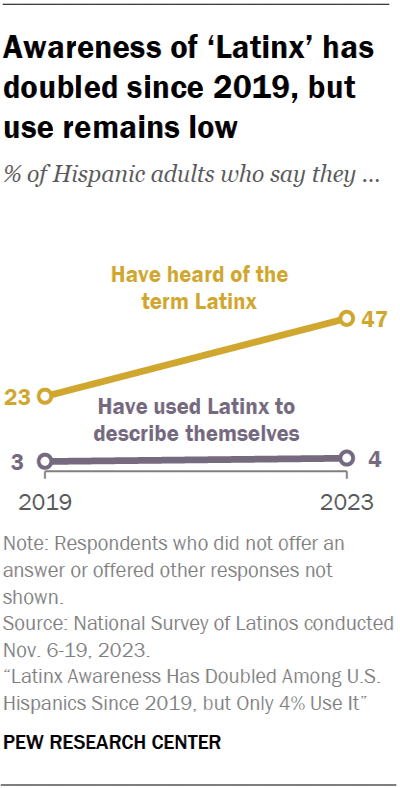
Latinx is a pan-ethnic identity term that has emerged in recent years as an alternative to Hispanic and Latino. Some news and entertainment outlets, corporations, local governments and universities use it to describe the nation’s Hispanic population.
However, its popularity has brought increased scrutiny in the U.S. and abroad. Some critics say it ignores the gendered forms of Spanish language, while others see Latinx as a gender- and LGBTQ+-inclusive term. Adding to the debate, some state lawmakers favor banning the use of the term entirely in government documents; Arkansas has done so already.
A 2023 survey found that awareness of Latinx has doubled among U.S. Hispanics since 2019, with growth across all major demographic subgroups. Still, the share of Hispanic adults who use Latinx to describe themselves is statistically unchanged: In 2023, 4% said they use it, compared with 3% in 2019.
Latinx is also broadly unpopular among Latinos who know the term. Three-in-four Latino adults who are aware of Latinx say the term should not be used to describe Hispanics or Latinos.
The emergence of Latinx coincides with a global movement to introduce gender-neutral nouns and pronouns into many languages that have traditionally used male or female constructions. In the U.S., Latinx first appeared more than a decade ago, and it was added to a widely used English dictionary in 2018.
What is ‘Latine’ and who uses it?
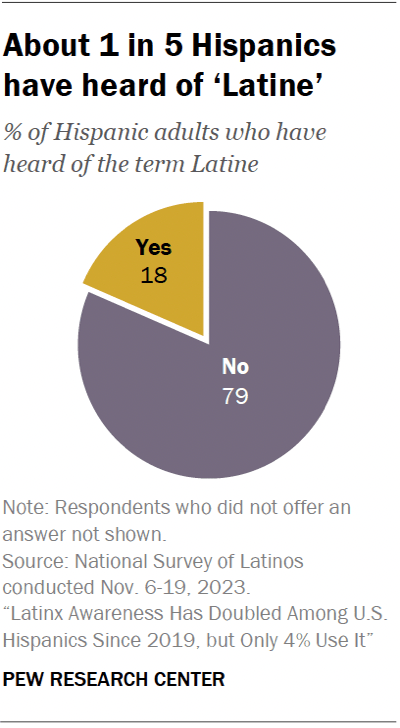
Latine is another pan-ethnic term that has emerged in recent years. Our 2023 survey found that 18% of U.S. Hispanics have heard of the term.
Similar to familiarity with Latinx, awareness of Latine varies by age, education and sexual orientation. Among Latinos, awareness of Latine is highest among those ages 18 to 29 (22%), college graduates (24%) and lesbian, gay and bisexual adults (32%).
How do factors like language, parental background and last name affect whether someone is considered Hispanic?
Many U.S. Hispanics have an inclusive view of what it means to be Hispanic:
- 78% of Hispanic adults said in a 2022 Center survey that speaking Spanish is not required to be considered Hispanic. English-dominant Hispanics were more likely than Spanish-dominant Hispanics to say so (93% vs. 64%).
- 33% of Hispanic adults said in a 2019 survey that having two Hispanic parents is not an essential part of what being Hispanic means to them. Another 34% said it was important but not essential and 32% said it was essential.
- 84% of Hispanic adults said in a 2015 survey that having a Spanish last name is not required.
Views of Hispanic identity may change in the coming decades as broad societal changes, such as rising intermarriage rates, produce an increasingly diverse and multiracial U.S. population.
Today, many Hispanic families include people who are not Hispanic:
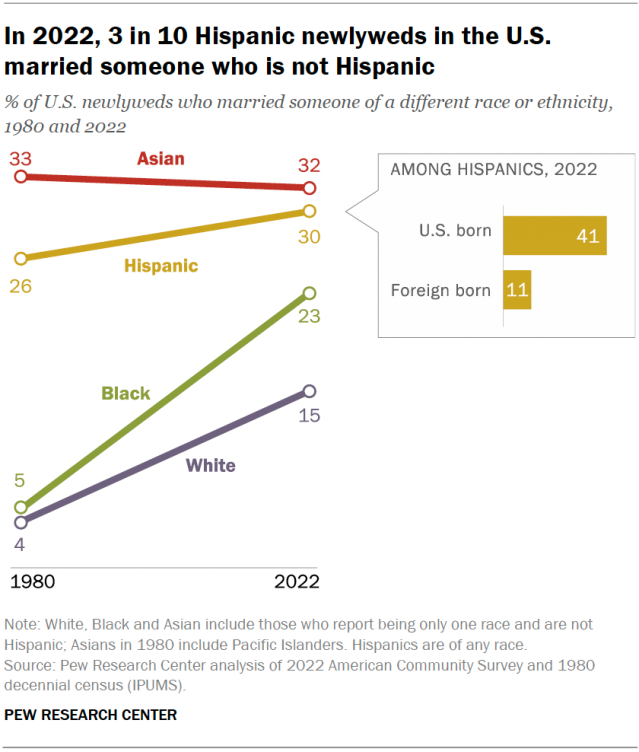
Spouses: Among all married Hispanics in 2022, 22% had a spouse who is not Hispanic. And in a 2023 Center survey, 27% of Hispanics with a spouse or partner said their spouse or partner is not Hispanic.
Newlyweds: In 2022, 30% of Hispanic newlyweds married someone who is not Hispanic. Among them, 41% of those born in the U.S. married someone who is not Hispanic, compared with 11% of immigrant newlyweds, according to an analysis of ACS data.
Parents: Our 2015 survey found that 15% of U.S. Hispanic adults had at least one parent who is not Hispanic. This share rose to 29% among the U.S. born and 48% among the third or higher generation – those born in the U.S. to parents who were also U.S. born.
What role does skin color play in whether someone is Hispanic?
In surveys like those from the Census Bureau, skin color does not play a role in determining who is Hispanic or not. However, as with race, Latinos can have many different skin tones. A 2021 Center survey of Latino adults showed respondents a palette of 10 skin colors and asked them to choose which one most closely resembled their own.
Latinos reported having a variety of skin tones, reflecting the diversity within the group. Eight-in-ten Latinos selected one of the four lightest skin colors. By contrast, only 3% selected one of the four darkest skin colors.
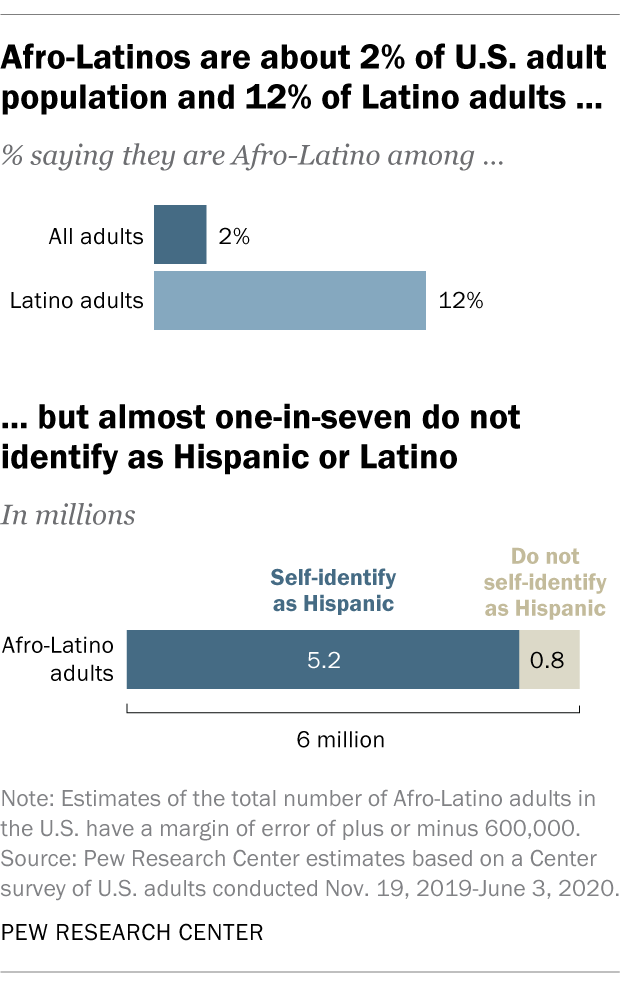
A majority of Latino adults (57%) say skin color shapes their daily life experiences at least somewhat. Similar shares say having a lighter skin color helps Latinos get ahead in the U.S. (59%) and that having a darker skin color hurts Latinos’ ability to get ahead (62%).
Are Afro-Latinos Hispanic?
Afro-Latino identity is distinct from and can exist alongside a person’s Hispanic identity. Afro-Latinos’ life experiences are shaped by race, skin tone and other factors in ways that differ from other Hispanics. While most Afro-Latinos identify as Hispanic or Latino, not all do, according to our estimates based on a survey of U.S. adults conducted in 2019 and 2020.
In 2020, about 6 million Afro-Latino adults lived in the U.S., making up about 2% of the U.S. adult population and 12% of the adult Latino population. About one-in-seven Afro-Latinos – an estimated 800,000 adults – do not identify as Hispanic.
Are Brazilians, Portuguese, Belizeans and Filipinos considered Hispanic?
Officially, Brazilians are not considered Hispanic or Latino because the federal government’s definition applies only to those of “Spanish culture or origin.” In most cases, people who report their Hispanic or Latino ethnicity as Brazilian in Census Bureau surveys are later recategorized – or “back coded” – as not Hispanic or Latino. The same is true for people with origins in Belize, the Philippines and Portugal.
An error in how the Census Bureau processed data from a 2020 national survey omitted some of this coding and provided a rare window into how Brazilians (and other groups) living in the U.S. view their identity.
In 2020, at least 416,000 Brazilians — more than two-thirds of Brazilians in the U.S. — described themselves as Hispanic or Latino on the ACS and were mistakenly counted that way. Only 14,000 Brazilians were counted as Hispanic in 2019, and 16,000 were in 2021.
The large number of Brazilians who self-identified as Hispanic or Latino highlights how their view of their own identity does not necessarily align with official government definitions. It also underscores that being Hispanic or Latino means different things to different people.
How many people with Hispanic ancestry do not identify as Hispanic?
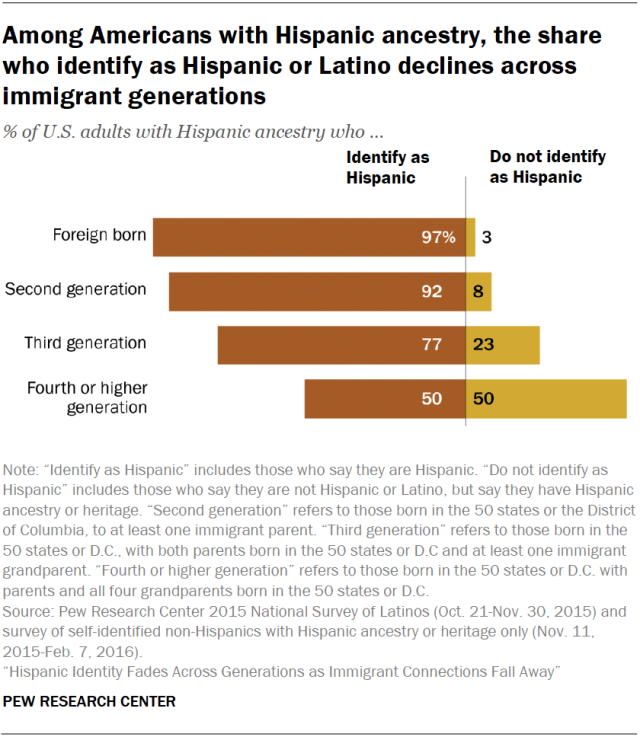
Of the 42.7 million adults with Hispanic ancestry living in the U.S. in 2015, an estimated 5 million people, or 11%, said they do not identify as Hispanic or Latino, according to a 2015-16 Center survey. These people aren’t counted as Hispanic in our surveys.
Notably, Hispanic self-identification varies across immigrant generations. Among immigrants from Latin America, nearly all identify as Hispanic. But by the fourth generation, only half of people with Hispanic heritage in the U.S. identify as Hispanic.
Note: This is an update of a post originally published on May 28, 2009.


